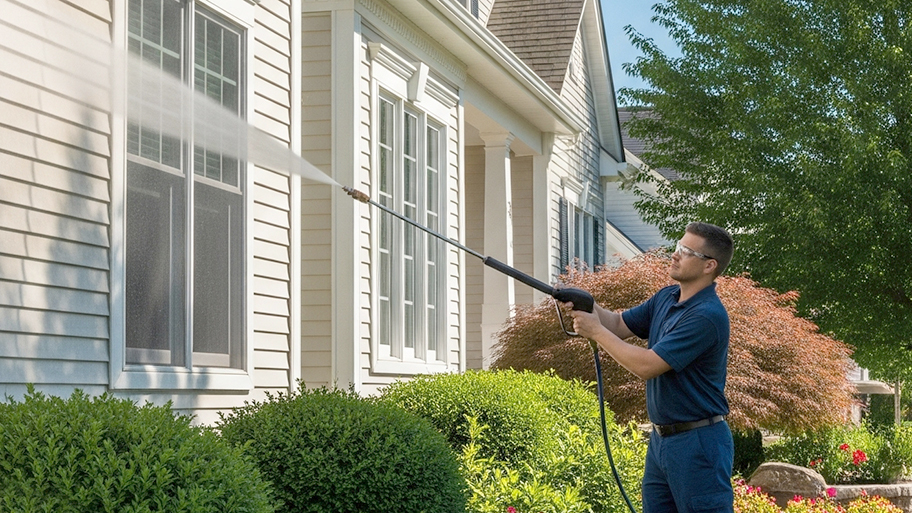
Need to breathe new life into your dirty siding and trim? Explore the cost to pressure wash a house to boost your curb appeal instantly.
Pressure makes diamonds and sparkling vinyl siding


If you’re wondering whether or not to pressure wash your siding, the type of material it’s made of is one of the main factors that will help you decide if it’s the right move. Vinyl siding is more resistant to damage than wood and metal alternatives, so pressure washing is a suitable way to get it back in shape. Use this guide to find out exactly how to pressure wash vinyl siding, as well as how to prepare to keep you and your home safe to avoid costly damage.
Can you pressure wash vinyl siding? The answer to that question comes down to how well you prep. Because a pressure washer is a power tool, it’s vital to make sure both you and the more fragile elements of your home exterior are well protected before getting started.
When pressure washing, always make sure to arm yourself with the proper protective gear. Safety goggles will keep your eyes out of harm’s way from pressurized splashback, and ear plugs will limit any hearing damage from the noisy machine.
You’ll also need to make sure your surroundings are clear of any objects that could become damaged or get in your way during the pressure cleaning process. Take care to remove electrical wires and, if that’s not possible, turn off your electrical breaker to keep such hazards at bay while washing. And cover any fragile exterior home elements—like wooden window frames, shutters, and metal gutters—with plastic sheets to protect them from harm. You’ll also want to cover your plants and gardens so they don’t accidentally get blasted.
Get to know the differences between pressure washer tips beforehand so you don’t wind up using the wrong one. Red tips have a zero-degree spray span and are extremely pressurized, so you’ll want to avoid using them for gentler projects like this.
Instead, opt for green (25-degree) and yellow (15-degree) tips for exterior cleaning purposes. White tips have a 50-degree spray angle and are less likely overall to cause damage, making them a great option for beginners to get the feel for pressure washing to start out. You’ll also need a black tip for applying detergent.

The splash back when pressure washing is no joke, so make sure to put enough distance between yourself and the surface you’re cleaning to stay safe. In general, standing three feet away from your siding will do the trick, but you may want to start further away and move closer as you get comfortable.
Attach your pressure washer to the garden hose and fill the reservoir with a vinyl siding cleaning solution. Although you can clean with water alone, taking this extra step will ensure you don’t need to pressure wash your house again so soon.
Fit the black tip onto your pressure washer and apply detergent working from bottom to top in a left-to-right motion. Continue until all siding (at least on one side of the house) is accounted for. Then repeat on the remaining sides of the house. Let sit briefly—10 to 15 minutes—to allow detergent enough time to do its job.
Empty pressure washer reservoir of cleaning detergent and rinse it to remove the product completely. Then, switch to a white, green, or yellow tip (whichever you feel most comfortable using) and wash away detergent on your siding working from top to bottom and left to right until all detergent is removed. Repeat on other sides of the house.
Empty and unplug the pressure washer then inspect your siding for any spots you might have missed. Clean those spots by hand with dish soap, a sponge, and warm water. Finally, let it dry, stand back, and appreciate your hard work.
Going the DIY route for a project like this greatly reduces the cost to pressure wash your house, which ranges from $100 to $750 if you hire a pro to do it. On the flip side, you may want to outsource this task to a power washing company near you if you don’t feel comfortable handling such a powerful tool.
From average costs to expert advice, get all the answers you need to get your job done.

Need to breathe new life into your dirty siding and trim? Explore the cost to pressure wash a house to boost your curb appeal instantly.

The cost to pressure wash a patio depends on the size of the surface and the type of patio you have, as well as whether you DIY or hire a pressure washing pro.

Pressure washing your fence can restore its appearance and keep your home looking great. Learn how much it costs based on factors like square footage and material.

Who power washes houses? Hiring a power washing professional is the best choice, as this expert has the know-how and equipment to do the job correctly.

Considering DIY pressure washing your home instead of hiring a pro? We’ll help you weigh the pros and cons of each option.

Your house sees a lot of rain, snow, dirt, and debris over the seasons. So, how often should you power wash your house? Find out with this guide.